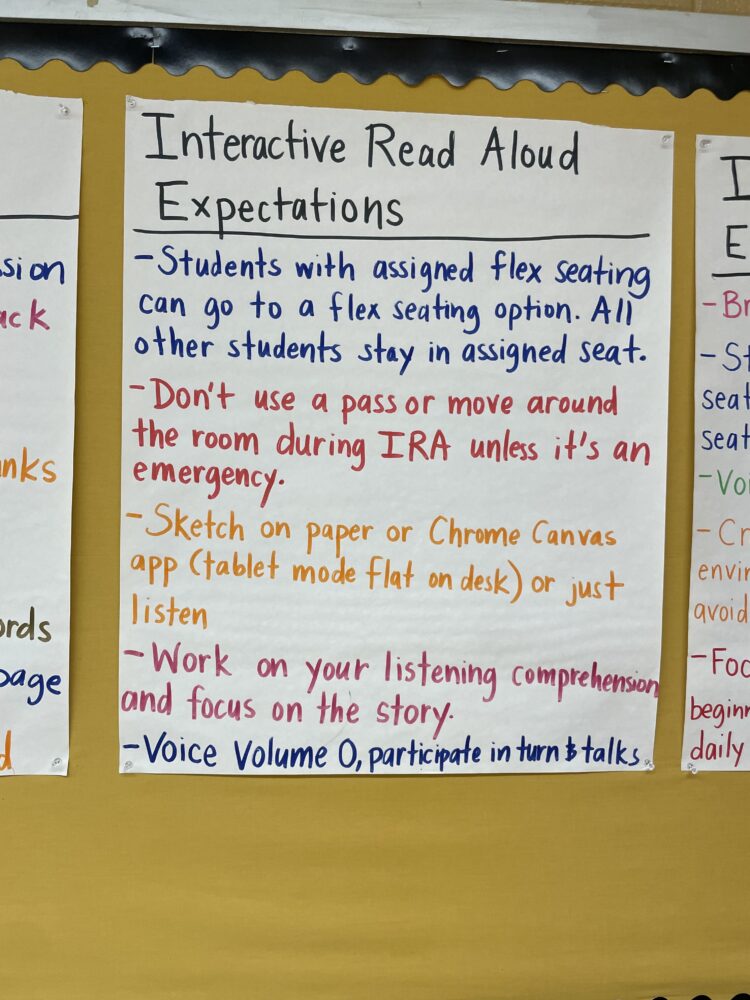Anyone who reads my blog or follows me on Facebook or Instagram knows that I love a good anchor chart. I consider anchor charts the best, most useful form of classroom decorations. As I looked around my 8th grade ELA classroom the other day, I realized that some anchor charts stand the test of time across a school year and stay relevant while other anchor charts just need to be around for a particular unit or shorter chunk of time. So, I figured writing a blog post about the 5 “evergreen” anchor charts that I leave up in my room all school year was in order. Here they are.
Evergreen Anchor Chart 1: What Does Fluent Reading Look Like?
Every day during reading units, I start the class period out with a routine we call “Oral Reading Fluency.” Students are given a starting page based on the book they’re reading for our current reading unit and read starting on that page to their table partner for one minute. Then the opposite table partner reads for one minute from the page in their book. It’s a quick, simple way to give students practice reading aloud without using outdated practices like round robin and popcorn reading.
At the beginning of the school year, we talk about how reading fluency isn’t about how fast you read the words on the page. It’s about reading with expression, monitoring your reading and making self-corrections when appropriate, phrasing words in meaningful chunks, pausing appropriately at periods and commas, using word-solving strategies to pronounce unknown words, reading at an appropriate rate, and using intonation to match the mood of the text.
I refer to this anchor chart often after Oral Reading Fluency and use it as a tool for students can give each other feedback on one aspect of their reading fluency.

Evergreen Anchor Chart 2: Interactive Read Aloud Expectations
During reading units, we always have a read aloud that I am reading to students. In our historical fiction reading unit, that book is a historical fiction novel. In our narrative nonfiction reading unit, I read 5 different narrative nonfiction picture books. In our expository nonfiction reading unit, I read short nonfiction articles. Regardless of the genre of our reading unit, the “Interactive Read Aloud Expectations” anchor chart is a must.
There are a few “classroom management-focused” anchor charts that stay up all year, and this is one of them. I sometimes use this anchor chart to review read aloud expectations prior to reading for the day. Other times, I use the anchor chart after our interactive read aloud so students can self-evaluate how they did with following a few of the expectations. In desperate times, I pause the read aloud to remind the class of a specific expectation that isn’t being followed.

Evergreen Anchor Chart 3: Independent Reading Expectations
If you want your students to become readers, then you need to give them consistent time in class to get hooked into independent reading books of their choice. As an 8th grade this school year, we’ve also committed the first 15 minutes of study hall time to only independent reading. (Spoiler alert: This has been a game-changer!) If your expectations for independent reading are strong and consistent, most students are going to fully enjoy and engage in this time.
That’s why I love the Independent Reading Expectations anchor chart. It really sets the stage for creating a classroom environment for reading. Like the IRA anchor chart, an anchor chart focused on behavior expectations works great for previewing expectations before independent reading time and having students self-evaluate behaviors after independent reading time. For other ideas to maximize independent reading time, make sure to also check out this blog post.

Evergreen Anchor Chart 4: Citing Text Evidence
In almost all the reading responses we do, and Exit Tickets students complete during reading units, they’re asked to cite text evidence to support their thinking. Since this is a common occurrence in our ELA class, anchor charts focused on citing textual evidence are a must.
The three evergreen anchor charts on citing text evidence that I leave up for the year are:
- Citing Text Evidence: This anchor chart breaks down the basics of how to cite textual evidence properly.
- Sentence Starters for Introducing Text Evidence: This anchor chart gives sentence starters that help students place text evidence in their Reading Responses in a variety of ways.
- Tricky Text Citations: Citing text evidence conventions can get even trickier when students are trying to cite dialogue and/or sentences that end in a question mark or explanation point.

Evergreen Anchor Chart 5: Sentence Types
It is easy to get frustrated about students not writing in complete sentences. That’s why in all my writing units, I use “Sentence Level Writing Activities” to bring students back to the sentence level. Students practice writing sentences with appositives, compound sentences, complex sentences, sentences with items in a series, and sentences with two adjectives and one noun in relation to the topic of that writing unit. I don’t require students to incorporate every sentence they practice into their final draft of writing, but I have been loving the variety of sentence types of the use of complete sentences in general I’ve seen from my 8th grade students this school year.
These anchor charts have stayed up as evergreen anchor charts to help reinforce sentence level writing, regardless of the writing unit we’re in.






